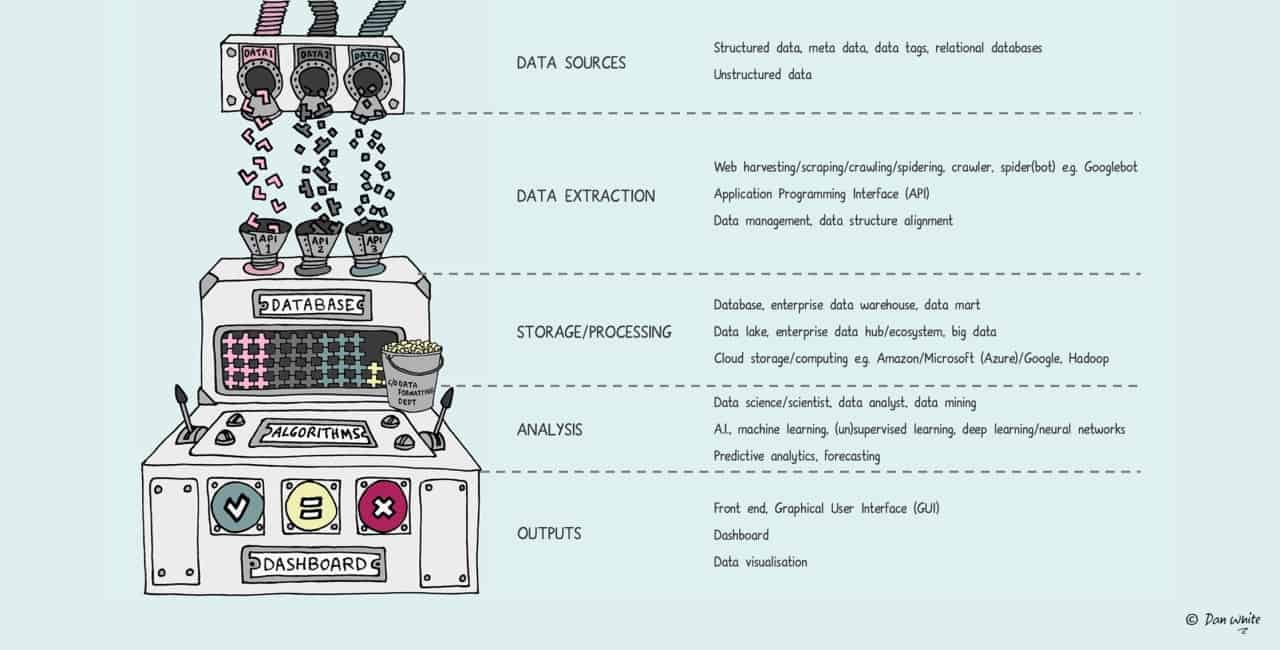The How-To Guide for Understanding Data Ecosystems
- Datameer, Inc.
- July 12, 2022

To understand why understanding data ecosystems are so important let’s take a look at the following example.
In 2017, The Economist published a story titled,
“The world’s most valuable resource is no longer oil, but data.”
The following year, Purple sec reported that 62% of businesses experienced phishing and social engineering attacks.
Correlation does not usually equal causation – but not in this case.
The amount of data we have has increased, but not without a commensurate increase in the number of cyber attacks.
What does this mean for us marketers? How do we keep tabs on all our data and data systems?
The answer is taking control of our data Ecosystem .
What Is A Data Ecosystem?

A data ecosystem is a set of data gathering and analysis infrastructure, systems, or applications used in an organization.
Companies rely on data ecosystems to take charge of their data and better understand their customers to make more appropriate marketing decisions.
Because digital ecosystems, like biological ecosystems, are predicted to grow over time, the term “ecosystem” is used.
Layers of A Typical Data System.
To understand this, Let’s picture a scenario.
Imagine yourself going up to the checkout counter of your local convenience store.
You have items in your cart that you put onto the conveyor belt.
The clerk scans each item into the checkout system , and the system tallies your total amount due.
You pay for your items, and the cashier gives you your receipt.

Behind this simple everyday process is an incredible amount of data.
First, each item you purchase has a record in the checkout system that identifies its price.
The price is most likely linked to a unique product identifier provided by a product management system.
Once your transaction is complete, the system will store transaction information such as the payment method. The checkout system will then prompt the inventory management system for stock level monitoring.
This is one of many examples of the data processing and interconnectivity within our data systems today.
With this in mind, let’s define the three layers that make up an Ideal Data Ecosystem.
1. The infrastructural layer
At the heart of every data, the ecosystem is infrastructure. Infrastructure serves as the foundational premise that houses every data ecosystem.
In our scenario above, infrastructure would refer to the hardware and software services that help capture, gather, and arrange data. These might be systems like our physical servers, databases, network infrastructure, etc.
2. Applications
Applications are the walls and roof of our data ecosystem –the services and tools that act upon the data to make it usable.
Considering our example, the inventory management system, the checkout application, and our store website are good examples of applications.
Applications produce transactional data that is stored in our production systems. They also serve as data points and sources for analytics.
3. Analytics
Analytics serves as the front door through which teams access their data ecosystem house.
The data in our production systems and applications are extracted via ETL into data systems like Data Warehouses. This data can be used for further analysis and reporting.
While application systems sometimes provide their own basic analytics, their analytic features are rarely sufficient.
A dedicated analytics platform searches and summarizes the data, offers a far more intuitive interface and includes a suite of tools purpose-built to help teams make data analysis quicker.
The Benefits of Understanding Data Ecosystems with a 360 view
Understanding what makes up your ecosystem is the first step to taking control of your data environment.
Customers leave data traces when they utilize your systems and services.
Being able to collect, wrangle and monitor this data is what makes the difference.
Here are 3 benefits of understanding and monitoring your Data Ecosystem:
1. Valuable marketing analytics to inform and validate your digital strategy.
2. A better understanding of your customers.
3. Informed knowledge of what can or can’t be integrated into your data ecosystem and the risks involved.
Additional Considerations in understanding data ecosystems
Data Security
With the prevalence of hackers, Companies must develop transparent data governance and cybersecurity principles for how you can gather data, utilize it, store it, and be safeguarded and dispose of it.
Data Governance
Since the Facebook scandal in 2018 and Mark Zuckerberg’s public apology, users are now more aware of their right to privacy online.
A user now has to know how you collect their data, be notified that their data is being collected and what that data will be used for.
Brands that want to develop an ideal data ecosystem should take data governance policies and regulations seriously.
A few examples of data governance legislations are:
-
- GDPR (General Data Protection Regulation)
- Health Information Technology for Economic and Clinical Health (HITECH)
- Health Insurance Portability and Accountability Act (HIPAA- esp Electronic Health- EHI)
- California Online Privacy Protection
Democratized Data Modeling
Data modeling and transformation are critical to any analytics process, particularly for marketers and marketing analysts.
The data transformation tools and techniques you use will play a critical role in determining whether your organization can unlock the full potential of your data ecosystem and its analytics assets.
Businesses must invest in analytics platforms with user-friendly interfaces and GUIs; Interfaces that encourage self-service data analysis.
A perfect example of such a tool is Datameer.
Reliant funding referred to Datameer as the door to real-time access to information.
With Datameer, you can transform data and improve analysis and collaboration within Snowflake.
To experience Datameer in action, Sign up for your free trial today!


